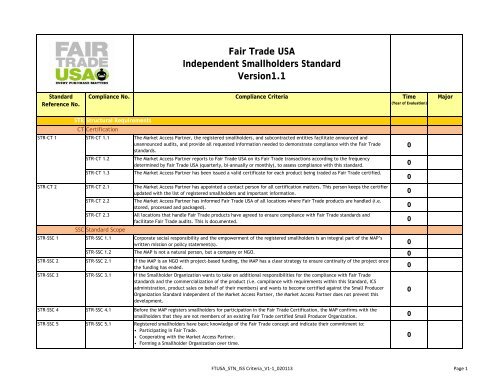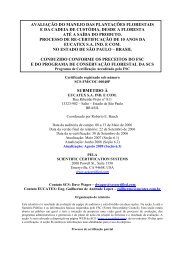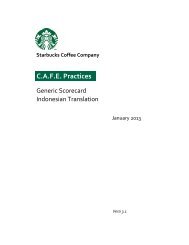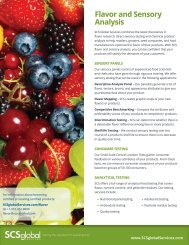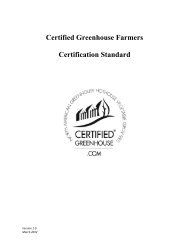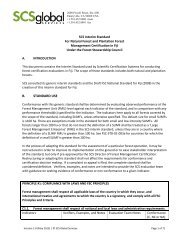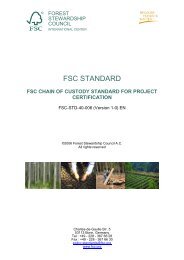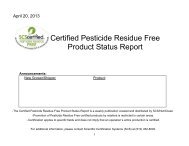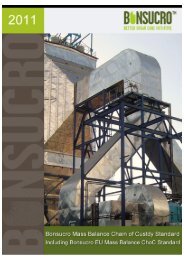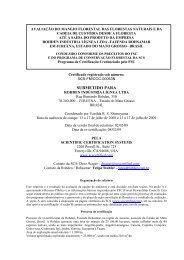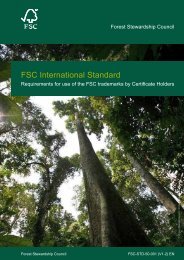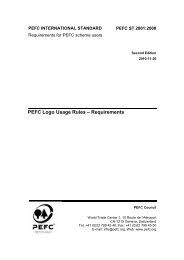Standard - SCS Global Services
Standard - SCS Global Services
Standard - SCS Global Services
Create successful ePaper yourself
Turn your PDF publications into a flip-book with our unique Google optimized e-Paper software.
<strong>Standard</strong>Reference No.Compliance No. Compliance Criteria Time(Year of Evaluation)MajorSTR-SSC 6STR-MS 1STR-MS 2EM-DM 1EM-DM 2STR-SSC 6.1At least 50% of the registered smallholders are small producers according to the definition given in the Fair Trade USA<strong>Standard</strong>s Glossary.0STR-SSC 6.2 At least half of the volume that the MAP sells as Fair Trade per year is produced by small producers. 0STR-SSC 6.3 At least half the volume of each Fair Trade sale is produced by small producers. 0MS Monitoring SystemsSTR-MS 1.1The Market Access Partner identifies requirements at risk of non-compliance within the following sections of this<strong>Standard</strong>: Conditions of Employment, Social Responsibility, and Environmental Stewardship. These requirements are 1identified in a written risk assessment.STR-MS 1.2 The written risk assessment is updated by the MAP every three years, at minimum. 1STR-MS 2.1An Internal Control System (ICS) has been designed and planned to monitor the implementation of practices mandatedby the following sections of this <strong>Standard</strong>: Conditions of Employment, Social Responsibility and Environmental1Stewardship.STR-MS 2.2 The Internal Control System has been implemented, and is effective. 3STR-MS 2.3The Internal Control System ensures that all registered smallholders comply with the following sections of this<strong>Standard</strong>: Conditions of Employment, Social Responsibility and Environmental Stewardship.3EM EmpowermentDM Development and Management of the Fair Trade PlanEM-DM 1.1The Market Access Partner has appointed a Fair Trade Officer responsible for all measures directed at socialempowerment and economic development of the registered smallholders, as well as the implementation of Fair Trade 0<strong>Standard</strong>s and the necessary communication between all parties.EM-DM 1.2 The responsibilities for this/these person(s) are clear and documented. 0EM-DM 2.1The Market Access Partner has conducted or financed a written needs assessment identifying the social, economic andenvironmental development needs of the registered smallholders, workers, community and environment. 0EM-DM 3EM-DM 2.2 The needs assessment analyzes how Fair Trade may help to address those needs. 0EM-DM 2.3 The needs assessment is based on surveys/ other primary data collected with the registered smallholders. 0EM-DM 2.4The needs of farm workers are taken into account in the needs assessment, focusing especially on those groups ofworkers that form majority of the workforce (i.e. if migrant workers form the majority of the workforce, the needs 0assessment should focus on their needs).EM-DM 3.1Before any portion of the Fair Trade Premium is spent: the Market Access Partner and the Fair Trade committeetogether develop a written “Fair Trade Plan”, based on the needs assessment, with the objective to meet the needs of 1the registered smallholders, workers, community and/or environment.EM-DM 3.2 If there is more than one Fair Trade Committee, each Fair Trade Committee develops its own Fair Trade Plan. 1FTUSA_STN_ISS Criteria_V1‐1_020113 Page 2
<strong>Standard</strong>Reference No.Compliance No. Compliance Criteria Time(Year of Evaluation)MajorEM-DM 4EM-DM 4.1The Fair Trade Plan includes an implementation plan, which lists the objectives, timelines, budget, and requiredactions. Objective and outcome of the required actions are measurable and measurements are defined. 1EM-DM 4.2 All activities that will be funded with Fair Trade Premium are included in the Fair Trade Plan. 1EM-DM 5EM-DM 4.3The plan includes training and capacity-building measures for the registered smallholders to take on increasedresponsibility.1EM-DM 5.1 The Fair Trade Plan is updated annually. 1EM-DM 5.2 The Fair Trade Plan is approved by the General Assembly annually before it is implemented. 1 MEM-DM 5.3The progress of the Fair Trade Plan is documented and shared with the registered smallholders annually in an annualprogress report. The written report includes measurements of the success against the intended outcome of allactions, and the Fair Trade Committee/board of the Smallholder Organization answers the following questions:• Were the actions proposed in the Fair Trade Plan carried out? If not, why?• When were the actions carried out?• At what cost?• Was the objective achieved or is further action needed?1EM-DM 5.4The Market Access Partner supports the Fair Trade committee in developing the Fair Trade Plan, the annual progressreport, and in making democratic and transparent decisions.1EM-DM 6 EM-DM 6.1 Applicable as soon as the Smallholder Organization is legally registered or Year 6 at the latest: the SmallholderOrganization takes over responsibility for the Fair Trade Plan progress reports.6EM-DM 7EM-DM 7.1The Market Access Partner supports the Fair Trade Committee and registered smallholders in implementation of theFair Trade Plan.1EM-DM 8EM-DM 7.2EM-DM 7.3EM-DM 7.4EM-DM 8.1EM-DM 8.2If there is no significant progress towards achieving timelines and objectives in the Fair Trade Plan, the Market AccessPartner contracts a third party to support the Fair Trade Committee.3The Fair Trade Committee vets the third party to ensure that it has the requisite experience.The Market Access Partner can demonstrate that the third party has the qualifications necessary to support theregistered smallholders and Fair Trade Committee.3The Market Access Partner, in collaboration with the Fair Trade Committee, creates an accounting system thataccurately tracks the expenses and budget in the Fair Trade Plan, and identifies the distribution of Fair Trade1Premiums in a transparent manner.The Fair Trade Committee is accountable to all of the registered smallholders on the use of the Fair Trade Premium.EM-DM 8.3 There is no evidence of misuse in the management of the Fair Trade Premium. 0 MEM-DM 9 EM-DM 9.1 The Market Access Partner provides training to the Fair Trade Committee on the management of the Fair TradePremium accounting system.331FTUSA_STN_ISS Criteria_V1‐1_020113 Page 3
<strong>Standard</strong>Reference No.Compliance No. Compliance Criteria Time(Year of Evaluation)MajorEM-DM 10EM-DM 10.1Applicable as soon as the Smallholder Organization is legally registered or Year 6 at the latest: the SmallholderOrganization takes on responsibility for maintaining the accounting system that accurately tracks the expenses andbudget in the Fair Trade Plan, and identifies the distribution of Fair Trade Premiums in a transparent manner. 6EM-DM 10.2 Applicable when the registered smallholders formed not one, but several Smallholder Organizations: if theSmallholder Organizations decide on several separate premium plans and accounting systems (rather than one jointpremium plan and accounting system), the Fair Trade Premium is channeled to each Smallholder Organization. Each 6Smallholder Organization ensures transparent administration of Fair Trade Premium use.EM-DM 11 EM-DM 11.1 Applicable where there are workers employed by the registered smallholders: The Fair Trade Plan includes at leastone project or activity intended to benefit workers.3EM-DM 11 EM-DM 11.2 The activity should benefit all workers and focuses on those groups of workers that form majority of the workforce(i.e. if migrant workers form the majority of the work force, the Fair Trade Plan should focus on their needs). 3EM-PTA 1EM-PTA 2PTA Inclusive Participation, Transparency and Financial AccountabilityEM-PTA 1.1 The Fair Trade Committee is elected prior to initial certification. 0 MEM-PTA 1.2An initial training is provided by the Market Access Partner to new Fair Trade Committee members on the functioningand responsibilities of a Fair Trade Committee.0EM-PTA 2.1The Fair Trade Committee is chosen in free, fair and transparent elections and this election process is documented.0 MEM-PTA 2.2All registered smallholders are eligible for nomination, and are able to participate in the election of the Fair TradeCommittee. The registered smallholders strive to reflect the diversity of their group in those elected in the Fair TradeCommittee.EM-PTA 2.3 Every registered smallholder is represented by one Fair Trade Committee. 0EM-PTA 2.4 No registered smallholder is represented by more than one Fair Trade Committee. 0EM-PTA 2.5Where delegate/representation systems are applied, these are clearly defined and offer equitable representation toall members of the organization.0EM-PTA 2.6 All registered smallholders understand the role and responsibilities of the Fair Trade Committee. 0EM-PTA 3 EM-PTA 3.1 The Market Access Partner has declared in writing that it does not interfere with the independent decision making ofthe Fair Trade Committee.00EM-PTA 4 EM-PTA 4.1 Applicable as soon as the Smallholder Organization is legally registered or Year 6 at the latest: before communalcapital and assets are acquired with Premium money or Year 6 at the latest, the Smallholder Organization is legallyregistered and has defined the internal rules of the organization (i.e. in the form of statutes, a constitution or bylaws).6FTUSA_STN_ISS Criteria_V1‐1_020113 Page 4
<strong>Standard</strong>Reference No.Compliance No. Compliance Criteria Time(Year of Evaluation)MajorEM-PTA 5EM-PTA 5.1Applicable as soon as the Smallholder Organization is legally registered or Year 6 at the latest: the internal rules ofthe Smallholder Organization (i.e. statutes, constitution, or by-laws) mandate that a General Assembly (GA) withequitable voting rights for all members is the supreme decision-making body of the organization. 6 MEM-PTA 6EM-PTA 5.2EM-PTA 6.1This requirement applies where the registered smallholders have formed multiple Smallholder Organizations. It will beassessed as soon as these Smallholder Organizations are legally registered, or Year 6 at the latest:If the Smallholder Organizations decide to use one joint Fair Trade Plan and system of premium accounting (notseveral that are separate), the decision on the use of the Fair Trade Premium is taken by the General Assembly ofSmallholder Organizations.Applicable as soon as the Smallholder Organization is legally registered or Year 6 at the latest: the leadership team(i.e. board of directors) is chosen in free, fair and transparent elections and this election process is documented. 6 M6EM-PTA 6EM-PTA 6.2EM-PTA 6.3Applicable as soon as the Smallholder Organization is legally registered or Year 6 at the latest: all members of theSmallholder Organization are eligible for nomination, and are able to participate in the election of the leadershipteam (i.e. board of directors).Applicable as soon as the Smallholder Organization is legally registered or Year 6 at the latest: wheredelegate/representation systems are applied, these are clearly defined in the internal rules of the organization (i.e.statutes, constitution or by-laws), and offer equitable representation to all members of the organizations. 66EM-PTA 6.4Applicable when the registered smallholders formed not one, but several Smallholder Organizations: thisrequirement will be evaluated as soon as the Smallholder Organizations are legally registered or Year 6 at the latest:if the Smallholder Organizations make decisions together, and use one joint premium plan and one joint premiumaccounting system (not several separate premium plans and premium accounting systems), there is a democratically 6elected leadership team (i.e. board of directors) that represents all Smallholder Organizations.EM-PTA 7EM-PTA 6.5Applicable when the registered smallholders formed not one, but several Smallholder Organizations: thisrequirement will be evaluated as soon as the Smallholder Organizations are legally registered, or Year 6 at the latest:if the Smallholder Organizations make decisions together, they have implemented statutes or internal regulations for adelegate system for the election of the leadership team (i.e. board of directors) and General Assemblies (ifapplicable). The system is based on the principle that each Smallholder Organization has an equal or proportionatenumber of delegates.EM-PTA 7.1 The list of registered smallholders is kept up to date and is available to registered smallholders. 0EM-PTA 7.2The Market Access Partner has written rules that determine who can participate in the program, and provide detailson the approval process. These rules are followed.0EM-PTA 7.3Requests by new small producers to join an existing producer group are agreed to by the Fair Trade Committee.EM-PTA 7.4If the Market Access Partner is unable to incorporate new producers, the Market Access Partner can justify and provewhy it cannot do so.060FTUSA_STN_ISS Criteria_V1‐1_020113 Page 5
<strong>Standard</strong>Reference No.Compliance No. Compliance Criteria Time(Year of Evaluation)MajorEM-PTA 8EM-PTA 9EM-PTA 8.1EM-PTA 8.2EM-PTA 9.1EM-PTA 9.2EM-PTA 9.3EM-PTA 9.4EM-PTA 9.5Applicable as soon as the Smallholder Organization is legally registered or Year 6 at the latest: the member list ofthe Smallholder Organization is updated regularly and is available to members.6Applicable as soon as the Smallholder Organization is legally registered or Year 6 at the latest: the internal rules ofthe Smallholder Organization (i.e. statutes, constitution, or by-laws) include rules that determine who can become amember, and provide details on: the application process, approval process, and timelines for public registration. 6These rules are followed.The Market Access Partner maintains records of all Fair Trade sales, including information on Fair Trade buyers,volumes sold as Fair Trade, premium calculation, and prices received, and it shares this information regularly with the 0Fair Trade Committee/ Smallholder Organization.The Fair Trade Committee / Smallholder Organization is responsible for communicating information on sales, the FairTrade Premium, and the Fair Trade Plan to the registered smallholders.0The Fair Trade Committee/ Smallholder Organization is responsible for soliciting issues and concerns of the registeredsmallholders and sharing with the Market Access Partner.0There are regular meetings between the Market Access Partner and the Fair Trade Committee/SmallholderOrganization and these meetings are documented.0The registered smallholders are aware of the purpose of the Fair Trade Premium and thesystem by which Fair Trade Premium receipts and expenses are accounted for. 0EM-PTA 10EM-PTA 10.1 The Fair Trade Committee, with support of the Market Access Partner, organizes a General Assembly at least once ayear.1EM-PTA 10.2 The General Assembly includes all of the registered smallholders. 1EM-PTA 10.3 Where delegate/representation systems are applied, these are clearly defined and offer equitable representation toall members of the organization. 1EM-PTA 11EM-PTA 11.1EM-PTA 11.2EM-PTA 11.3EM-PTA 11.4EM-PTA 11.5Applicable as soon as the Smallholder Organization is legally registered or Year 6 at the latest: the SmallholderOrganization holds a General Assembly at least once a year.6Applicable as soon as the Smallholder Organization is legally registered or Year 6 at the latest: procedures to call theassembly and determine quorum are adhered to, as defined in the statutes/constitution.6Applicable as soon as the Smallholder Organization is legally registered or Year 6 at the latest: members areinformed of when the General Assembly will take place at least two weeks in advance.6Applicable as soon as the Smallholder Organization is legally registered or Year 6 at the latest: wheredelegate/representation systems are applied, these are clearly defined and offer equitable representation to allmembers of the organization.Applicable when the registered smallholders formed not one, but several Smallholder Organizations: thisrequirement will be evaluated as soon as the Smallholder Organizations are legally registered or Year 6 at the latest:if the Smallholder Organizations make decisions together, and use one joint premium plan and one joint premiumaccounting system (not several separate premium plans and premium accounting systems), they organize a GeneralAssembly of all Smallholder Organizations at least once a year.EM-PTA 12 EM-PTA 12.1 Where a significant number of permanent workers are employed on the farms of the registered smallholders, workersare invited to the General Assembly in order to observe and participate in the discussion of topics that relate to them. 066FTUSA_STN_ISS Criteria_V1‐1_020113 Page 6
<strong>Standard</strong>Reference No.Compliance No. Compliance Criteria Time(Year of Evaluation)MajorEM-PTA 13EM-PTA 13.1The minutes of the Fair Trade Committee meetings clearly record all decisions made, as well as the consultation withregistered smallholders that took place prior to decision-making.0EM-PTA 13.2 The minutes of the Fair Trade Committee meetings are signed by all members of the Fair Trade Committee. 0EM-PTA 13.3 The minutes of the Fair Trade Committee meetings are shared with the registered smallholders. 0EM-PTA 14EM-PTA 14.1 The minutes of the General Assembly clearly record all decisions made, and are signed by the Fair TradeCommittee/leadership team of the Smallholder Organization and at least one of the registered smallholders.1EM-PTA 14.2 There is a list of participants in the General Assembly included in the minutes. 1EM-PTA 15EM-PTA 15.1 All annual reports, budgets and accounts, if any outside of the Fair Trade Plan and progress measurement, arepresented to, and approved by, the General Assembly.6EM-PTA 15.2 Measures are in place to improve members’ understanding of the annual report and accounts. 6EM-PTA 16 EM-PTA 16.1 At least one person or committee within the General Assembly is responsible for managing theadministration and book-keeping. 6EM-PTA 17 EM-PTA 17.1 Fair Trade Plans and reports are accessible to registered smallholders. 0EM-PTA 18 EM-PTA 18.1 Applicable as soon as the Smallholder Organization is legally registered or Year 6 at the latest: all records, books,and documentation are accessible to members of the Smallholder Organizations.6EM-PTA 19EM-PTA 19.1EM-PTA 19.2The Fair Trade Committee appoints a trustee (the Market Access Partner, a bank, credit union or NGO) of the FairTrade Premium funds.0The trustee acknowledges in writing that the registered smallholders, represented by the Fair Trade Committee, arethe rightful recipients of the FT Premium. This acknowledgement is sent to the Fair Trade Committee. 0EM-PTA 19.3The trustee has established a separate bank account to receive the Fair Trade Premium on behalf of the registeredsmallholders. 0EM-PTA 19.4 The trustee and at least one Fair Trade Committee member are joint signatories of the account. 0EM-PTA 19.5All expenditure of the Fair Trade Premium and related issues are made in the name of theFair Trade Committee. 0EM-PTA 19.6 The Fair Trade Committee acknowledges the receipt of the Fair Trade Premium in writing. 0EM-PTA 20 EM-PTA 20.1 Handling of the Fair Trade Premium is externally audited annually by an independent party in years when high FairTrade Premium volumes (i.e. greater than $15,000 USD) are generated or spent.0EM-PTA 21 EM-PTA 21.1 The MAP, in collaboration with the Fair Trade Committee, provides a report, as well as audited accounts of Fair TradePremium use, to the Fair Trade Committee and registered smallholders annually or upon request at any time. 0EM-PTA 22 EM-PTA 22.1 Regular administrative and organizational capacity-building trainings are given to Fair Trade Committeerepresentatives. This ensures that they can gradually take over management of the Fair Trade Premium.3FTUSA_STN_ISS Criteria_V1‐1_020113 Page 7
<strong>Standard</strong>Reference No.Compliance No. Compliance Criteria Time(Year of Evaluation)MajorEM-PTA 23EM-PTA 24ED-FTP 1ED-FTP 1EM-PTA 23.1 Applicable as soon as the Smallholder Organization is legally registered or Year 6 at the latest: the SmallholderOrganization has an active bank account with more than one signatory registered to its name.6EM-PTA 23.2 Applicable as soon as the Smallholder Organization is legally registered or Year 6 at the latest: the premium ischanneled to this account through the Market Access Partner.6EM-PTA 23.3 Applicable when the registered smallholders formed not one, but several Smallholder Organizations: thisrequirement will be evaluated as soon as the Smallholder Organizations are legally registered or Year 6 at the latest.If the Smallholder Organizations decide on one joint premium plan (rather than several separate ones) they have a 6joint bank account in place.EM-PTA 24.1 The Market Access Partner/Smallholder Organization takes measures to improve the registered smallholders’understanding of annual reports and accounts and to increase knowledge on, pricing and international market3mechanisms.EM-PTA 24.2 These trainings are documented. Records are kept on file. 3ED Economic DevelopmentFTP Fair Trade PriceED-FTP 1.1For all Fair Trade purchases, the price paid to the registered smallholders is not less than the Fair Trade MinimumPrice or the market/contractual price, whichever is higher.0 MED-FTP 1.2If the product is bought from a registered smallholder, but not on Fair Trade terms, and the Market Access Partnerwants to potentially sell the product as Fair Trade later, the Market Access Partner pays at least the market price to 0the registered smallholder.ED-FTP 1.3If the product is bought from a registered smallholder but not on Fair Trade terms, and later sold as Fair Trade, anyprice adjustment will have to be paid at the end of the season. This occurs when the Fair Trade minimum price ishigher than the market price, or when the Fair Trade price is set at the FOB price level and the Market Access Partneris able to sell the Fair Trade product at a higher FOB price than necessary according to agreed margins.0ED-FTP 2ED-FTP 3ED-FTP 1.4ED-FTP 2.1The Market Access Partner maintains records of price levels, exchange rates, and how they were agreed upon, in orderto demonstrate that the market price is based on agreements/contracts with other suppliers.0The Market Access Partner must ensure that new Fair Trade prices announced by Fair Trade USA are applied to newcontracts from the effective date as listed on the price announcement.0ED-FTP 2.2 The Market Access Partner must ensure that for existing contracts all pricing Terms & Conditions are honored. 0ED-FTP 3.1 Charges for inputs and services are agreed upon in advance and are part of the Fair Trade agreement. 0ED-FTP 3.2 Cost break downs of inputs and services are available, transparent and coherent. 0ED-FTP 3.3 Costs of inputs and services are not higher than normal market prices. 0FTUSA_STN_ISS Criteria_V1‐1_020113 Page 8
<strong>Standard</strong>Reference No.Compliance No. Compliance Criteria Time(Year of Evaluation)MajorED-PFT 1PFT Fair Trade PremiumED-PFT 1.1ED-PFT 1.2ED-PFT 1.3ED-PFT 1.4ED-PFT 1.5The Market Access Partner pays the correct amount of Fair Trade Premium to the Fair Trade Committee (or theSmallholder Organization once it is established), as stipulated in the Fair Trade Price and premium table.0 MIf the registered smallholders are organized as more than one Fair Trade Committee (FTC)/Smallholder Organization(SO) that uses separate premium plans and accounting systems (rather than one joint premium plan and accountingsystem), the Market Access Partner channels Fair Trade Premium to each FTC/SO. The total amount of Fair TradePremium is split between the FTCs/SOs according to the amount of product delivered to the Market Access Partner bythe members of that FTC/SO.The Market Access Partner ensures that no deductions are made from premium payments to the Fair TradeCommittee.0The Market Access Partner has a written contract with the Premium Payer to ensure correct terms and transfer ofpremium payments to the Market Access Partner.0No part of the Premium is used for any means that is not agreed to in the Fair Trade Plan.ED-PFT 1.6 The Fair Trade Premium is not used to cover the running costs of the Market Access Partner. 0ED-PFT 1.7The Premium is paid to the Premium bank account as soon as possible, but no later than one month after receipt ofPremium payment from the Premium payer. 000ED-CE 1CEConditions of Employment(This section is applicable to all workers employed by the Market Access Partner and by the registered smallholders. Note: some exemptions are included for smallholders andoperations that do not employ a significant number of workers. The certification body will define what constitutes a significant number of workers depending on variousfactors).ED-CE 1.1ED-CE 1.2Salaries exceed, or are in line with, sector regulations, CBA's which are in place for an employer, the regional average,or legal minimum wages for similar occupations, whichever is highest.0 MOther conditions of employment (e.g. additional types of leave, statutory benefits) exceed, or are in line with nationallaw.0ED-CE 1.3 The employer has specified wages for all functions. 0ED-CE 1.4For remuneration based on production, quotas, or piecework, the pay rate allows the worker to earn the proportionateminimum wage or relevant industry average (whichever is higher) during normal working hours.0 MED-CE 1 ED-CE 1.5 Rates for piecework are agreed under the CBA or agreement on working conditions with the workers committee, andtheir method of calculation is transparent and available to workers.3ED-CE 2ED-CE 2.1ED-CE 2.2Payment is made in legal tender, that is, cash or cash equivalent (check, direct deposit). Where payment is made bydirect deposit, the employer does not have withdrawal access to workers’ bank accounts.0Payments are made to workers directly and on time, according to an appropriate payment schedule that is monthly orbi-weekly. The payment schedule has been communicated to workers. In-kind payments are not allowed, except inregions where they are legally permissible, agreed upon by both parties, and documented, including a definition of thevalue of the goods.0FTUSA_STN_ISS Criteria_V1‐1_020113 Page 9
<strong>Standard</strong>Reference No.Compliance No. Compliance Criteria Time(Year of Evaluation)MajorED-CE 2ED-CE 3ED-CE 4ED-CE 2.3ED-CE 2.4ED-CE 3.1ED-CE 3.2ED-CE 4.1ED-CE 4.2Where a significant number of workers are employed, workers receive pay slips with each pay check that provide aclear account of wages earned, allowances, bonuses, overtime payment, and all deductions in detail. This Information 0is also available upon request.Where a significant number of workers are employed, the employer provides the worker with access to a properappeal mechanism if discrepancies in payment are found.0The employer complies with local law regarding the provision of health insurance, other social security benefits,including pension and disability insurance, maternity leave, and vacation time to workers.0In cases where permanent workers are not entitled to health insurance benefits, the employer provides the equivalentbenefits in the form of Private Health Insurance or comparable health services.0Where an elected workers’ organization exists, the organization has negotiated the conditions of work with theemployer.0Workers have the right to choose their representatives to take part in any negotiations, without external interference.ED-CE 5 ED-CE 5.1 Where a significant number of workers are employed, all permanent workers have a legally binding, written contractthat clearly describes the terms of hire and safeguards workers from loss of pay in the case of illness, disability or 3accident. The notice period for termination of the contract is identical for employer and worker.ED-CE 5.2Where a significant number of workers are employed, all permanent workers have received a copy of the contract orat minimum, have free access to the original, signed contract.3ED-CE 6ED-CE 6.1All positions that are of a regular nature are staffed with permanent workers, and legal obligations are not avoidedthrough the excessive use of time-limited employment contracts.3ED-CE 6.2Where a significant number of workers are employed, an overview of the company's labor needs is produced eachyear, indicating the periods in which non-permanent workers will be needed.3ED-CE 6.3Where a significant number of workers are employed, time-limited contracts or any subcontracting are only issued tonon-permanent workers during peak periods, in the case of special tasks and under exceptional circumstances. This 3includes seasonal workers.ED-CE 6.4Where a significant number of workers are employed, temporary workers who are employed for a period of 3 monthsor more of uninterrupted service have a legally binding and signed contract with job description that is accessible to 6workers.ED-CE 7 ED-CE 7.1 The employer and worker representatives meet to discuss how they can improve wages and productivity in mutuallybeneficial ways, including generating ideas for how to move towards “living wages” over time.30FTUSA_STN_ISS Criteria_V1‐1_020113 Page 10
<strong>Standard</strong>Reference No.Compliance No. Compliance Criteria Time(Year of Evaluation)MajorSR Social ResponsibilityND Non-Discrimination(This section is applicable to registered smallholders and to workers employed by the Market Access Partner or the registered smallholders)SR-ND 1 SR-ND 1.1 There is no discrimination against registered smallholders or potential new program participants, particularly on thebasis of race, color, sex, gender, sexual orientation, disability, marital status, family obligations, age, religion,political opinion, language, property, nationality, ethnicity or social origin, or any other condition that could give riseto discrimination in relation to: participation, rules for program participation, voting rights, the right to be elected,access to markets, access to training, technical support or any other benefits that the program offers.There is no discrimination against workers, particularly on the basis of race, color, sex, gender, sexual orientation,disability, marital status, family obligations, age, religion, political opinion, membership of unions or other workers’representative bodies, national extraction or social origin, or any other condition that could give rise to discriminationin: recruitment, promotion, access to training, remuneration, allocation of work, termination of employment,retirement or other activities.0 MSR-ND 2 SR-ND 2.1 Registered smallholders who come from disadvantaged/minority groups have been identified and documented. 3SR-ND 3 SR-ND 3.1 The Market Access Partner has developed a program to improve the social and economic position of registeredsmallholders who come from disadvantaged/minority groups.3SR-ND 4SR-ND 4.1The Market Access Partner and the registered smallholders do not engage in, support or tolerate the use of corporalpunishment, mental or physical coercion, verbal abuse or any other form of harassment.0 MSR-ND 5SR-ND 4.2SR-ND 4.3SR-ND 5.1SR-ND 5.2SR-ND 5.3Where a significant number of workers are employed, a written policy and a disciplinary procedure with the right toappeal are in place and are communicated to workers both verbally and in writing. 3Where many registered smallholders employ a significant number of workers, the Market Access Partner designs andimplements a monitoring and record system to prevent improper disciplinary practices.6The Market Access Partner and registered smallholders do not engage in, support or tolerate behavior, includinggestures, language, and physical contact, that is sexually intimidating, abusive or exploitative.0 MWhere a significant number of workers are employed, a written policy that clearly prohibits unwanted conducts of asexual nature is in place and communicated to workers.3Where many registered smallholders employ a significant number of workers, the Market Access Partner designs andimplements a monitoring and record system in order to prevent unwanted conducts of a sexual nature. 6FTUSA_STN_ISS Criteria_V1‐1_020113 Page 11
<strong>Standard</strong>Reference No.Compliance No. Compliance Criteria Time(Year of Evaluation)MajorSR-FL 1FLSR-FL 1.1 There is no kind of forced labor, including bonded labor or human trafficking. 0 MSR-FL 1.2SR-FL 1.3SR-FL 1.4Work is not exacted from any person under the threat of any penalty and for which the said person has not offered himor herself voluntarily.0The employer does not retain any part of the workers’ salary, benefits, property or documents in order to force themto remain.0The employer does not use any form of physical or psychological measures requiring workers to remain employed.SR-FL 1.5 Bonded labor caused by debts or loans does not occur. 0SR-FL 2 SR-FL 2.1 A worker's employment is not conditional on the employment of their spouse. Spouses are not required to work.0SR-PC 1SR-PC 2PCFreedom from Forced Labor and Human Trafficking(This section is applicable to all workers employed by the Market Access Partner and by the registered smallholders).Protection of Children and Young Persons(This section is applicable to all workers employed by the Market Access Partner and by the registered smallholders).SR-PC 1.1 Children below the age of 15 (or below the working age defined by national law, if higher) are not employed. 0 MSR-PC 1.2SR-PC 1.3SR-PC 1.4SR-PC 2.1Policies and procedures are in place to ensure that children below the age of 15 (or below the working age defined bynational law, if higher) are not employed or allowed into production areas. Documentation must be maintained for allworkers legally classified as minors, including: Name; Date of Birth; Address; and a letter of consent authorizing theminor to work, signed by the parents or legal guardian.Where children below the age of 15 (or below the working age defined by national law, if higher) have been employedin the past, or are found working, a remediation policy has been put in place to ensure that the children do not enterinto worse forms of employment. Where children below the age of 15 (or below the working age defined by nationallaw, if higher) have been employed in the past, or are found working, the employer has a register of all workers underthe age of 15 (or below the working age defined by national law, if higher) indicating their age and their work, and therelevant remediation policy is in effect.If the Market Access Partner has identified child labor as a risk, it must implement procedures to prevent childrenbelow the age of 15 (or below the working age defined by national law, if higher) from being employed for any workand children below the age of 18 (or below the age of legal adulthood as defined by national law, if higher) from beingemployed in dangerous and exploitative work.If children of the registered smallholders below the age of 15 (or below the working age defined by national law, ifhigher) help their relatives with farm work after school and/or in holidays, it is ensured that such work does notjeopardize schooling, is within reasonable limits, and that a member of the family supervises and guides the child. 00313SR-PC 2.2If children of the registered smallholders below the age of 15 (or below the working age defined by national law, ifhigher) help their relatives with farm work after school and/or in holidays, the work does not jeopardize the child’ssocial, moral or physical development and does not constitute a hazard to the child’s health. 0SR-PC 2.3Children below the age of 15 (or below the working age defined by national law, if higher), of workers employed bythe MAP or registered smallholders do not work for the MAP, or any registered smallholder.0FTUSA_STN_ISS Criteria_V1‐1_020113 Page 12
<strong>Standard</strong>Reference No.Compliance No. Compliance Criteria Time(Year of Evaluation)MajorSR-PC 3 SR-PC 3.1 Workers under the age of 18 (or below the age of legal adulthood as defined by national law, if higher) do not carryout work which, by its nature or the circumstances under which it is carried out (e.g. handling chemicals, workingnight shifts), is likely to jeopardize their health, safety, development or morals.SR-FA 1SR-FA 2SR-FA 3FAFreedom of Association(This section is applicable to all workers employed by the Market Access Partner. Registered smallholders who are structurally dependent on hired labor and who employ asignificant workforce must comply with all of these criteria, while smallholders and operations that do not employ a significant number of workers are exempt from theFreedom of Association criteria. The certification body will define what constitutes a significant number of workers depending on various factors).SR-FA 1.1The employer recognizes in writing (making it known to workers), and in practice: the right of all employees toestablish or join an independent workers organization of their own choosing that is free from interference of theemployer, and the right to collective bargaining.SR-FA 1.2 Workers are encouraged to legally incorporate their own established workers' organization. 0SR-FA 2.1The employer does not interfere with the right to freedom of association by attempting to influence or obstructworkers’ organizations.0SR-FA 2.2Management allows workers to hold meetings and organize themselves during working time without interference(without deductions or required payments) and within reasonable limits.0SR-FA 3.1Neither workers nor their representatives are discriminated against or suffer other repercussions because of freelyexercising their right to organize or because of their membership or participation in legal activities in their workers’ 0organization.SR-FA 3.2 The employer keeps records for all cases of dismissals of union or workers’ committee members. 3SR-FA 3.3The employer maintains a register of all terminated contracts with details on circumstances/reasons for termination.SR-FA 4SR-FA 4.1 The employer ensures that all workers are provided with information from an independent source on their right tofreedom of association and the options available for workers organizations.6OHSR-FA 4.2SR-FA 4.3The employer provides working time (without deductions or required payments) upon request and within reasonablelimits for these training activities to take place.6The employer provides appropriate facilities and resources upon request for these training activities to take place.00 MOccupational Health & Safety(This section is applicable to all workers employed by the Market Access Partner and by the registered smallholders. Note: some exemptions are included for smallholders andoperations that do not employ a significant number of workers. The certification body will define what constitutes a significant number of workers depending on variousfactors).36SR-OH 1SR-OH 1.1Work processes, workplaces, machinery and equipment on the production site as well as worker transportation are assafe as possible, and equipped with adequate safety devices.0SR-OH 1.2 A maintenance and repair system is put in place to ensure a safe, clean and hygienic environment at all times. 3SR-OH 1.3The employer ensures that Personal Protective Equipment (PPE) is provided to workers free of charge, according totheir tasks, and that they are instructed and monitored in its proper use.0SR-OH 1.4Where a significant number of workers are employed, the employer provides all workers with necessary workingclothes appropriate to their tasks and free of charge. These working clothes are replaced regularly.0FTUSA_STN_ISS Criteria_V1‐1_020113 Page 13
<strong>Standard</strong>Reference No.Compliance No. Compliance Criteria Time(Year of Evaluation)MajorSR-OH 2SR-OH 2.1Where a significant number of workers are employed, the employer has implemented a written health and safety (HS)policy.3SR-OH 2.2Where a significant number of workers are employed, the written health and safety policy is based on a documentedrisk assessment.3SR-OH 3 SR-OH 3.1 Persons under the age of 18, disabled people, persons with incapacitating mental conditions; persons with chronic,hepatic or renal diseases, persons with respiratory diseases, and pregnant and nursing women only perform work that 0is appropriate to their physical capacity and that does not imply a health hazard.SR-OH 4 SR-OH 4.1 In cases where a change of work is necessary to comply with requirement SR-OH 3, the employer ensures thatalternative employment is found for any existing worker.0SR-OH 5SR-OH 5.1The employer provides first aid facilities and equipment to meet all reasonably foreseeable emergency first aidsituations.0SR-OH 5.2Where a significant number of workers are employed, there are trained first aid personnel available to respond toemergency first aid situations.0SR-OH 5.3Where a significant number of workers are employed, records are kept of all work accidents and related first aidresponse.0SR-OH 6SR-OH 6.1 Potable drinking water is clearly labeled and accessible to all workers during their working period. 0SR-OH 6.2Where a significant number of workers are employed, drinking water is analyzed at least every six months when waterpurity has been identified as a risk. 0SR-OH 6.3Where sanitary facilities are provided, these are clean and there are hand washing facilities next to the sanitaryfacilities. 1SR-OH 6 SR-OH 6.4 Where a significant number of workers are employed, sanitary facilities are provided separately for men and women(toilets, washing facilities and showers if needed due to agrochemical application). Where a large number of workersare employed, the employer provides an appropriate number of facilities (minimum proportion is 1 facility: 253workers).SR-OH 7 SR-OH 7.1 Where a significant number of workers are employed, a Health and Safety Officer is nominated to be in charge ofoccupational health and safety matters. This person brings health and safety issues to the attention of the employer. 3FTUSA_STN_ISS Criteria_V1‐1_020113 Page 14
<strong>Standard</strong>Reference No.Compliance No. Compliance Criteria Time(Year of Evaluation)MajorSR-OH 8SR-OH 9ES-MS 1ES-MS 2ES-IPM 1SR-OH 8.1 Seasonal training is provided for workers engaged in any potentially hazardous work. 3SR-OH 8.2Workers engaged in any potentially hazardous work are informed of the specific risks to mental, reproductive and/orneurological health.3SR-OH 8.3Where a significant number of workers are employed, these trainings are documented; records are kept on file.SR-OH 8.4SR-OH 8.5SR-OH 9.1Where a significant number of workers are employed, risk areas and potential hazards are clearly identified bywarning signs in all relevant languages, which include pictograms.3Where a significant number of workers are employed, written safety instructions and procedures include detailsregarding accident prevention and response, and are readily available to workers at their work place.3Workers handling hazardous chemicals are provided with adequate personal protective equipment free of charge.SR-OH 9.2 The employer ensures that the personal protective equipment is used. 0SR-OH 9.3 Workers do not take personal protective equipment (i.e. gloves, clothes, masks) to their homes. 0SR-OH 9.4Training on the use of the protective equipment and the risks associated with hazardous materials is provided at leastonce a year.0SR-OH 9.5Where a significant number of workers are employed, these trainings are documented; records are kept on file.ES Environmental StewardshipMS Monitoring SystemsES-MS 1.1The Market Access Partner organizes trainings on the criteria regarding environmental responsibility and safe chemicaluse. These trainings are documented; records are kept on file.0ES-MS 1.2 The majority of the registered smallholders attend. These trainings are documented; records are kept on file. 3ES-MS 2.1The Market Access Partner appoints at least one person to lead the operational steps required to comply with theEnvironmental Responsibility requirements within this standard.0ES-MS 2.2 The responsibilities of this person are clear and documented. 0ES-MS 2.3The person appointed has the knowledge (of production practices, agronomic challenges, cultural traditions,environmental risks) necessary to fulfill these responsibilities.0IPM Integrated Pest ManagementES-IPM 1.1The Market Access Partner provides training to the registered smallholders on the subject of integrated pestmanagement, including:• The monitoring of pests and diseases.• Alternative ways to control pests and diseases.3• Preventive measures against pests and diseases.• Measures to prevent pests and diseases from building up resistance to agrochemicals.ES-IPM 1.2 The majority of the registered smallholders attend. These trainings are documented; records are kept on file. 3300FTUSA_STN_ISS Criteria_V1‐1_020113 Page 15
<strong>Standard</strong>Reference No.Compliance No. Compliance Criteria Time(Year of Evaluation)MajorES-IPM 2 ES-IPM 2.1 Registered smallholders are able to demonstrate that agrochemicals are applied based on knowledge of pests anddiseases.6AC AgrochemicalsES-AC 1ES-AC 1.1The Market Access Partner compiles a list of the agrochemicals that are used for agricultural production that isincluded in the Fair Trade certificate.0ES-AC 1.2The list indicates which of those materials are on the Fair Trade USA Prohibited Materials List (PML) part 1 (Red List)and part 2 (Amber List).0ES-AC 2ES-AC 3ES-AC 1.3 The list is updated every three years, at minimum. 3ES-AC 2.1 Materials on the Fair Trade USA PML part 1 (Red List) are not used on Fair Trade crops. 0 MES-AC 2.2 The Market Access Partner implements measures to raise awareness of the PML among members. 3ES-AC 2.3 Awareness raising measures are documented and records are kept on file. 3ES-AC 2.4 Prohibited materials are clearly marked “not for use on Fair Trade crops”. 0ES-AC 3.1 The chemical storage area is locked and accessible only to trained and authorized personnel. 0ES-AC 3.2 The storage area is ventilated to avoid a concentration of toxic vapors. 0ES-AC 3.3 The storage area has the equipment necessary to handle accidents and spills, including absorbent materials. 0ES-AC 3.4 The storage area does not contain food. 0ES-AC 3.5 Hazardous materials are clearly labeled. Labels indicate contents, warnings, and intended uses. 0ES-AC 3.6 Information is available regarding the safe handling of hazardous materials (Material Safety Data Sheets). 00ES-AC 4 ES-AC 4.1 Agrochemical containers are not reused to store or transport food or water. 0ES-AC 5 ES-AC 5.1 The Market Access Partner provides training to members and workers who handle agrochemicals on the risks ofhandling these materials and on how to handle them properly.The training should address the following subjects, as appropriate:• How to store hazardous chemicals safely, ensuring that they cannot be reached by children.• How to understand the product label and other safety instructions for use made available by the manufacturer.• Container labels should indicate contents, warnings, and intended uses.• How to handle accidents and spills when preparing and applying chemicals.1• How to handle and safely dispose of empty containers, including the practices of triple rinsing and puncturingcontainers.• Intervals of time when people are not allowed to enter a sprayed area or field without any personal protectionequipment.ES-AC 5 ES-AC 5.2 The majority of the registered smallholders attend. These trainings are documented; records are kept on file. 1ES-AC 6 ES-AC 6.1 The Market Access Partner implements measures to ensure that all people, including registered smallholders andworkers, wear effective personal protective equipment (PPE) when handling pesticides or hazardous chemicals. 1ES-AC 7ES-AC 7.1The Market Access Partner continues to raise awareness among all members and workers of the hazards and risksrelated to agrochemicals, i.e. through a presentation, information material, or trainings.3ES-AC 7.2 Awareness raising measures are documented; records are kept on file. 6FTUSA_STN_ISS Criteria_V1‐1_020113 Page 16
<strong>Standard</strong>Reference No.Compliance No. Compliance Criteria Time(Year of Evaluation)MajorES-SW 1ES-SW 2SW Soil and WaterES-SW 1.1The Market Access Partner identifies land at risk of soil erosion and land that is already eroded in fields whereregistered smallholders plant Fair Trade crops. Land showing signs of soil erosion and land at risk of soil erosion havebeen recorded and results have been communicated to affected producers.ES-SW 1.2 Where soil erosion is a problem, remedial actions to improve the situation have been initiated. 6ES-SW 2.1The Market Access Partner provides training on practices that reduce and/or prevent soil erosion to registeredsmallholders situated in areas where soil erosion or risk thereof has been identified.6ES-SW 2.2The majority of registered smallholders who are affected by soil erosion attend. These trainings are documented andrecords are kept on file.6ES-SW 3ES-SW 3.1The Market Access Partner provides training and recommendations on how to improve soil fertility and support soilrebuilding.3ES-SW 3.2 The majority of the registered smallholders attend. These trainings are documented; records are kept on file. 3ES-SW 3.3Registered smallholders implement procedures and practices to improve and/or conserve soil fertility, following atleast the minimum requirements set by the Market Access Partner. The Market Access Partner reports on these3measures.ES-SW 4 ES-SW 4.1 The Market Access Partner has a written list of all water sources used for irrigating and processing Fair Trade crops.ES-SW 5ES-SW 5.1The Market Access Partner provides training to the registered smallholders on measures to use water efficiently and onhow to handle waste water. The training addresses the following subjects, as appropriate:• Estimating how much water is needed to irrigate and/or process your crop.• Measuring (or estimating) how much water is extracted from the source.• Measuring how much water is used for irrigation and/or processing.• Providing maintenance to the water distribution system adopting as applicable, methods to re-circulate, reuseand/or recycle water.• Waste water, the related health risks, methods for treating waste water and their implementation.Efficient irrigation methods.ES-SW 5.2 The majority of the registered smallholders attend. These trainings are documented; records are kept on file. 6ES-SW 6 ES-SW 6.1 Waste water from central processing facilities is handled in a manner that does not have a negative impact on waterquality, soil fertility or food safety.6GM Genetically Modified OrganismsES-GM 1ES-GM 1.1The Market Access Partner and the registered smallholders do not use genetically engineered seed or planting stockfor the Fair Trade crop(s).0 MES-GM 1.2 Potential GMO crops that pose risks are identified by the organization. 0ES-GM 1 ES-GM 1.3 The origin of seeds and planting stock for which genetic modification is common in the region is traced, to guaranteethat they are not GMO.0333FTUSA_STN_ISS Criteria_V1‐1_020113 Page 18
<strong>Standard</strong>Reference No.Compliance No. Compliance Criteria Time(Year of Evaluation)MajorES-BD 1ES-BD 2ES-BD 3BD BiodiversityES-BD 1.1ES-BD 1.2ES-BD 2.1The Market Access Partner and the registered smallholders avoid negative impacts on protected areas and areas withhigh conservation value, within or outside the farm or production areas.0The areas that are used or converted to production of the Fair Trade crop comply with national legislation in regard toagricultural land use.0The Market Access Partner and the registered smallholders implement activities to protect and enhance biodiversity.ES-BD 2.2 The Market Access Partner documents these activities. 6ES-BD 3.1The Market Access Partner and the registered smallholders maintain buffer zones around bodies of water andwatershed recharge areas and between production and areas of high conservation value.6ES-BD 3.2 Agrochemicals and fertilizers are not applied in buffer zones. 6ES-BD 4 ES-BD 4.1 If the registered smallholders carry out wild harvesting of Fair Trade products from uncultivated areas, they assure thesustainability and survivability of the collected species in its native habitat.1ES-BD 5ES-BD 5.1The Market Access Partner raises awareness among members about the protection of rare and endangered species andthe dangers of introducing alien invasive species.3ES-BD 5.2 Awareness raising measures are documented; records are kept on file. 3ES-BD 5.3 No collecting or hunting of rare or endangered species takes place. 3GHG Energy and Greenhouse Gas EmissionsES-GHG 1ES-GHG 1.1 The Market Access Partner keeps records of energy consumption. 3ES-GHG 1.2 The Market Access Partner takes measures to use energy more efficiently. 6ES-GHG 1.3 The Market Access Partner replaces non-renewable energy sources with renewable ones as far as possible. 6ES-GHG 2ES-GHG 2.1 The Market Access Partner and the registered smallholders work together to take measures to reduce GHG emissionsand increase carbon sequestration.6ES-GHG 2.2 The Market Access Partner reports on these measures. 6TR Trade RequirementsBR Basic RequirementsTR-BR 1 TR-BR 1.1 The Market Access Partner reports to Fair Trade USA on its Fair Trade transactions (according to the frequencydetermined by Fair Trade USA: quarterly, bi-annually or monthly). 0PS Product SourcingTR-PS 1 TR-PS 1.1 For newly certified producers, product that was produced more than one year before initial certification may not besold as Fair Trade. 06FTUSA_STN_ISS Criteria_V1‐1_020113 Page 19
<strong>Standard</strong>Reference No.Compliance No. Compliance Criteria Time(Year of Evaluation)MajorTR-PT 1PT Physical Product TraceabilityTR-PT 1.1 Only products grown by registered smallholders are sold as Fair Trade. 0 MTR-PT 1.2Voluntary for Market Access Partners that process cocoa, cane sugar, juice or tea: the products grown by registeredsmallholders are transported, stored, processed/manufactured and delivered separately from non-Fair Trade products,until the product is sold.TR-PT 2 TR-PT 2.1 Voluntary for Market Access Partners that process cocoa, cane sugar, juice or tea: Fair Trade products are markedclearly with a reference to Fair Trade (i.e. Fair Trade USA, FLO-CERT, the Fairtrade International ID number) so thatthey can be identified as Fair Trade certified.TR-PT 3 TR-PT 3.1 Market Access Partners that process cocoa, cane sugar, juice or tea are not required to fulfill physical traceabilityrequirements in the processing facility, but the volumes sold as Fair Trade are equivalent to the volumes produced byregistered smallholders (taking into account processing yields and losses).Market Access Partners processing cocoa, cane sugar, juice or tea and selling to operators that have a physicaltraceability system in place must physically separate the product during processing.00Market Access Partners processing cocoa, cane sugar, juice or tea and selling to operators that do not have a physicaltraceability system in place may mix Fair Trade input and non-Fair Trade input at the processing level. However, thefollowing requirements must be met:• The products have been produced by, and sourced from, registered smallholders before the sale of the Fair Tradeproduct.• The product from registered smallholders is delivered and processed in the same site where the Fair Trade product isprocessed.• The product from registered smallholders is of the same type and quality as the input used to process the Fair Tradeproduct.0 MTR-PT 4 TR-PT 4.1 Applicable to bananas only: the traceability system on each box indicates the packing station, date of packing and theidentification of the individual registered smallholder.0TD Traceability through DocumentationTR-TD 1 TR-TD 1.1 There is a written description of the product flow from the registered smallholders to the Market Access Partner.TR-TD 2TR-TD 2.1The Market Access Partner keeps records of products sourced from the registered smallholders as part of the FairTrade program, which indicate the name of the individual producer, date of purchase, product name, volume and theprice received by the member.00TR-TD 3TR-TD 2.2TR-TD 3.1TR-TD 3.2Records include the signature of the registered smallholder, verifying accuracy, and the registered smallholdersreceive a copy of the record.0Applicable as soon as the Smallholder Organization is legally registered or Year 6 at the latest: the Market AccessPartner provides copies of purchase documents to the Smallholder Organization and the registered smallholders forrecord-keeping purposes. Records include the signature of the registered smallholder, verifying accuracy.Applicable as soon as the Smallholder Organization is legally registered or Year 6 at the latest: the SmallholderOrganization keeps sales records on behalf of the registered smallholders. These are available to the registeredsmallholders upon request.66FTUSA_STN_ISS Criteria_V1‐1_020113 Page 20
<strong>Standard</strong>Reference No.Compliance No. Compliance Criteria Time(Year of Evaluation)MajorTR-TD 4 TR-TD 4.1 When the Market Access Partner sells a Fair Trade product, it indicates clearly in the sales documents (e.g. invoices,delivery notes) that the product is Fair Trade certified (use the three word term “Fair Trade USA”).0TR-TD 5 TR-TD 5.1 There are records of all Fair Trade sales. These records include:• The volume.• The name of the buyer.• The date of the transaction.• A reference to Fair Trade USA.0• A reference to purchase documentation that allows the certification body to link these records with thecorresponding sales documentation.TR-TD 6 TR-TD 6.1 If Fair Trade products are processed, there are records that specify the amount of product before and afterprocessing.0AG AgreementsTR-AG 1TR-AG 1.1This requirement does not apply if the Smallholder Organization has signed a binding purchase contract with theMarket Access Partner on behalf of all registered smallholders that covers all terms of trade stated in TR-AG 1.1:The Market Access Partner signs registration agreements with each individual registered producer.The registration agreement includes:• Information about the roles and responsibilities of the Fair Trade Committee/Smallholder Organization.• An overview of the requirements of Fair Trade production that the Market Access Partner is responsible for ensuring.• Terms of trade (including Fair Trade USA price and Fair Trade USA Premium).• Where Fair Trade USA minimum prices are set at the FOB level, payment terms for initial purchase and Fair Tradeadjustment, including deductions to be made from the Fair Trade minimum price.• Payment information.• Terms of delivery.• Documentation.• Reference to sourcing plans.• A description of all inputs and services provided, and indication of any deductions that may be relevant as a result ofthe provision of these inputs and services.• A mechanism to resolve conflicts.• Production requirements (e.g. meeting environmental requirements of this standard).0 MTR-AG 1.2Where the price is not fixed in the registration agreement (but it is agreed when and how the price will be fixed), theregistered smallholders receive a written receipt/ purchase order that details the terms of trade (price, premium, 0volume, etc.) for each specific purchase.TR-AG 2 TR-AG 2.1 The registration agreement is written in a language that the registered smallholders understand. 0TR-AG 3 TR-AG 3.1 The Market Access Partner ensures that the registered smallholders know and understand the terms ofthe registration agreement and the Fair Trade conditions.0TR-AG 4TR-AG 4.1The registration agreement between the Market Access Partner and the registered smallholders does not restrict themfrom selling to other buyers.0TR-AG 4.2The registration agreement between the Market Access Partner and the registered smallholders does not make thepurchase of certified products dependent on the purchase of non-certified products.0FTUSA_STN_ISS Criteria_V1‐1_020113 Page 21
<strong>Standard</strong>Reference No.Compliance No. Compliance Criteria Time(Year of Evaluation)MajorTR-AG 5 TR-AG 5.1 The Market Access Partner writes a sourcing plan summarizing expectations regarding volumes to be sourced in thenext 6 to 12 months, and shares this with the Fair Trade Committee/Smallholder Organization(s).0TR-AG 6 TR-AG 6.1 Applicable as soon as the Smallholder Organization is legally registered or Year 6 at the latest: where legallypermissible, the Smallholder Organization and the Market Access Partner negotiate an agreement on terms of trade forthe duration of one harvest period on behalf of all registered smallholders. This agreement on terms of trade defines:• Agreed minimum volume to be purchased under Fair Trade conditions.• Quality and delivery of the product by the registered smallholders.• Fair Trade minimum price, market/contract price and/or how the price will be determined, and when payment will 6be made (payment terms).• The Fair Trade premium and the party responsible for paying the Fair Trade price and premium to the producers.TR-AG 7TR-AG 7.1When credit or pre-finance is provided, the interest rate and conditions attached to the offer are agreed upon inadvance with the registered smallholders.0TR-AG 7.2 When credit or pre-finance is provided, the interest rates charged are not higher than the cost of borrowing. 0TR-AG 8 TR-AG 8.1 All elements of contracts with Fair Trade buyers are fulfilled at the conditions agreed in the contract, unless changesto the contract are mutually agreed upon between the Market Access Partner and its buyer in writing. This holds true, 0even if Fair trade International or Fair Trade USA publishes new Fair Trade Prices.CS Contract SuspensionTR-CS 1 TR-CS 1.1 When a producer or its buyer are suspended, within 6 months, the contracts that have already been signed arefulfilled, or new contracts are only signed with partners that the Market Access Partner had an existing traderelationship with (commercial transactions that have taken place in the previous 12 months). The volume traded 0 Mduring the suspension period does not exceed the greater of: 50% of the volumes traded in the preceding 12 months,or, the total volume contracted prior to the suspension.DC DecertificationTR-DC 1 TR-DC 1.1 If the Market Access Partner is decertified, it must stop selling any Fair Trade product from the date ofdecertification, even if it has signed Fair Trade contracts that are yet to be fulfilled. 0TR-DC 2 TR-DC 2.1 The Market Access Partner may not sell products to decertified operators for sales as certified products from the dateof decertification. Contracts that have not yet been shipped shall not be classified as Fair Trade contracts. 0TR-FTT 1FTT Use of Fair Trade TrademarkTR-FTT 1.1Organizations that are certified to sell Fair Trade certified products may use the Fair Trade certification mark inpromotional materials (such as brochures, websites or wholesale packaging).0TR-FTT 1.2Only licensed partners of Fair Trade USA may use the Fair Trade Certified certification mark on finished products andthey follow the Fair Trade USA Label Use Guide.0FTUSA_STN_ISS Criteria_V1‐1_020113 Page 22


